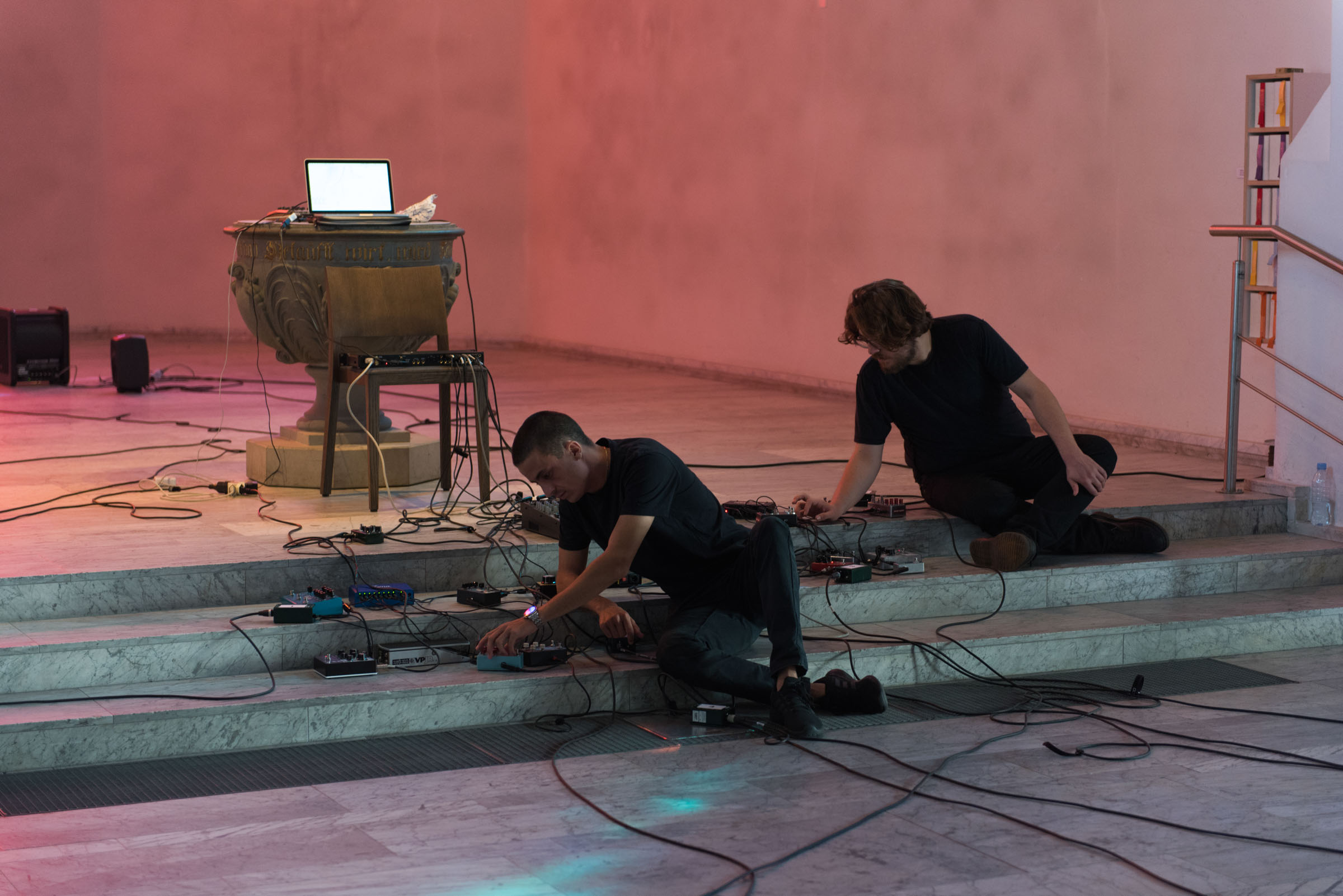
WAVE
2018
Im September 2018 führten Fernando Obieta und Gregor Vogel die dritte Ausgabe ihrer Klangperformance-Reihe WAVE auf. Im Gegensatz zu den beiden vorangegangenen Editionen war die Performance in drei separate Teile aufgeteilt, die im Laufe von zwei Tagen aufgeführt wurden.
Die beiden Künstler traten im Zusammenspiel mit einem Computer auf, auf dem ein Patch lief, der zufällig erzeugte Klänge ausgab, die sie mit Effektpedalen wie Reverb, Flanger oder Distortion veränderten. Bei jeder der drei Veranstaltungen war das Publikum eingeladen, zur Klanglandschaft beizutragen, indem es mit einer Triangel, einem Regenrohr oder einem Mikrofon interagierte, das an das Lautsprechersystem der Kirche angeschlossen war, das bei den Gottesdiensten verwendet wurde.
Das Werk erinnert an die protestantische Reformation, in der alle Arten von visueller Kunst und Ornamenten aus den Kirchen entfernt wurden, um sich auf die wesentlichen Bestandteile der Religion zu konzentrieren. Wie die führenden Köpfe der Reformation für die Gottesdienste vorschlugen, zielt WAVE darauf ab, die Grenze zwischen den Ausführenden und dem Publikum aufzubrechen. So waren alle Bereiche des Kirchenraums für alle Anwesenden zugänglich. Die beiden Künstler traten im Hauptraum und im Chorraum der Kirche sowie auf den dazwischen liegenden Treppen auf. Im Gegensatz zu zeitgenössischen Konventionen in der Performance-Kunst luden die Künstler die Anwesenden ein, mit ihnen zu sprechen und zu interagieren.
Alle drei Konzerte wurden inklusive der Stimmen und Geräusche des Publikums aufgezeichnet und auf Bandcamp veröffentlicht.
Um einen Vergleich zur protestantischen Reform zu ziehen, wurden alle Tracks auf dem Album nach Personen benannt, welche laut den beiden Künstlern als Reformator:innen der Musik bezeichnet werden können, wie z.B. John Cage, Kae Tempest oder Frank Ocean.
In September 2018 Fernando Obieta and Gregor Vogel performed the third iteration of their sound performance series which was called WAVE. In contrast to the preceding two editions, the performance was split into three separate parts staged over the course of two days.
The two artists performed in interplay with a computer running a pure data patch capable of outputting randomly generated sounds which they altered using effect pedals such as reverbs, flangers or distortions. For each of the three events, the audience was invited to contribute to the soundscape by interacting with a triangle, a rainmaker or a microphone connected to the church‘s speaker system used during the masses.
The work is reminiscent of the protestant reformation, during which all kinds of visual art and ornamentation were removed from churches to be able to focus on the essential components of religion. As the leading figures of the reformation proposed for the church services, WAVE aims to break the border between the performers and the audience. Thus all areas of the church space were accessible for everyone present. The two artists performed in the church‘s main room and the choir as well as on the stairs in between. In contrast to contemporary conventions in performance art, the artists invited the attendees to speak and interact with them.
All three concerts including the voices and sounds emitted by the audience were recorded and published on Bandcamp.
To draw a comparison to the protestant reformation, all tracks on the album are given the first names or nicknames of people, who the artists felt could be compared to reformators in music, like John Cage, Kae Tempest or Frank Ocean.



